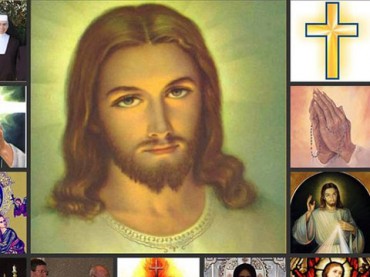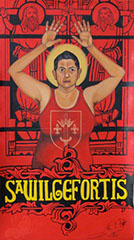
OPINION
In her art show at the Pacific School of Religion, “Queer Santas: Holy Violence,” artist Alma Lopez portrays a number of traditionally feminine Catholic saints androgynously. In doing so, she asks the viewer to “reconsider our ideas of religion, beauty and gender,” according to Kimberly Winston, who wrote a review of the show for Religion News Service.
While such a request initially seems innocuous, the comparison Lopez makes between select Catholic saints and transgender individuals is at best superficial and at worst a misrepresentation of the worldview to which these saints adhered.
 The show includes depictions of Saints Wilgefortis and Liberata, who according to legends grew beards after praying to God that they might be able to keep their vows of chastity. Saint Lucia, also depicted, either had her eyes gouged out when she prophesied the destruction of the governor of Syracuse or removed them herself to dissuade a suitor, according to different versions of the legend.
The show includes depictions of Saints Wilgefortis and Liberata, who according to legends grew beards after praying to God that they might be able to keep their vows of chastity. Saint Lucia, also depicted, either had her eyes gouged out when she prophesied the destruction of the governor of Syracuse or removed them herself to dissuade a suitor, according to different versions of the legend.
(As a side note, Wilgefortis and Liberata are no longer on the Catholic Calendar of Feast Days, meaning their historical existence cannot not be verified. Because Wilgefortis is the German version of the name Liberata, it is likely that the legends about these saints concerned the same person, whose legend is a pious fiction.)
Lopez, a visiting artist at UCLA who calls herself a “radical Chicana feminist lesbian,” wanted to show how these saints “tried to step out of the expected role for a woman of her time and, as a result, was the victim of terrible violence,” Winston says. Justin Tanis, a teacher at the school, tells Winston that these saints “were queer and violence was done to them for it.”
What Lopez and Tanis neglect to consider, however, is that these saints stepped out of society’s norms for entirely different reason than the transgender individual does nowadays. A woman is canonized as a saint because of her great love for God and demonstrated devotion to living for his glorification. Any action a saint performs is for the sake of glorifying God, often at the expense of personal gain.
The saints Lopez depicts ignored gender norms for God’s glorification, not to align their bodies more closely to how they feel. In fact, going against perceived societal norms was likely far from their minds when they made their choices. They sought only to give glory to God.
In contrast, transgender individuals believe that they, not God, have ultimate control over their bodies and will flout social norms to glorify their own choices. They demand that society view them as they view themselves – essentially a self-centered view.
Lopez does not appear to recognize the deep philosophical difference between the Santas and transgender individuals in their view of the body.
The Catholic faith of the Santas teaches that one’s body is a gift from God and not one’s own to manipulate at will: “Do you not know that your body is a temple of the Holy Spirit within you, which you have from God?” (1 Corinthiansch 6:19).
The fact that all the saints Lopez used for inspiration took a vow of chastity undeniably affirms their agreement with this premise. In their desire to dedicate their lives to God, these women dedicated the bodies they had been given to him as well.
By switching from one gender to another – taking hormones, undergoing surgery or simply “living” as the other gender – transgender individuals show they believe that the body is theirs to manipulate as they please.
“What’s in someone [sic] pants, how is that even relevant to how they even live their lives?” Janet Mock, a transgender activist born male who surgically transitioned to female as a teen, told The Telegraph in 2012. “Feminism and women’s rights have always been about autonomy and what you want to do with your body. One of the things you should always be able to do is to self-determine who you are.”
Pope Emeritus Benedict XVI pointed out the basic flaw in this way of thinking in his address on The Occasion of Christmas Greetings in 2012. “When the freedom to be creative becomes the freedom to create oneself, then necessarily the Maker himself is denied and ultimately man too is stripped of his dignity as a creature of God, as the image of God at the core of his being.”
Commingling the Santas and today’s transgender worldview recalls a much older dispute in Christianity. The Gnostics believed that the material world was evil and sought a purely spiritual existence, meaning that the body – already corrupt – could not be further corrupted by a lifestyle of immorality. The early church fathers argued strenuously against this worldview.
By putting their devotion to God ahead of society’s expectations for them, the Santas put themselves at great risk for God’s glory. They did not seek the validation of man. Surely Lopez knows that the Santas themselves would not have been flattered by her comparing them to people who reject the bodies God gave them.
While transgender issues deserve an honest and respectful discussion in society, Lopez’s misrepresentation of historical events and individuals is not the place to begin the dialogue.
(For deeper reading on gender and faith, I recommend Saint Augustine’s On Christian Doctrine and The City of God, and to a lesser extent Aristotle’s Nicomachean Ethics, from which I drew some general considerations about virtue.)
College Fix contributor Genevieve McCarthy is a student at Thomas Aquinas College.
Like The College Fix on Facebook / Follow us on Twitter
IMAGE: Alma Lopez via SantosQueer.Blogspot.in




Please join the conversation about our stories on Facebook, Twitter, Instagram, Reddit, MeWe, Rumble, Gab, Minds and Gettr.